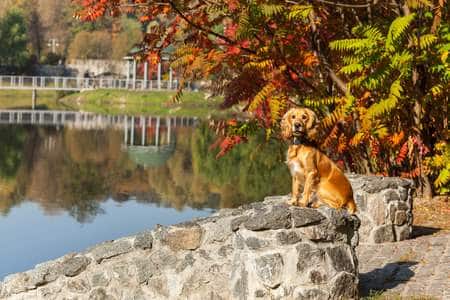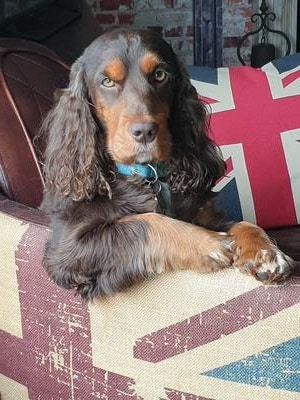A Small Gundog with a Happy Temperament
The English Cocker Spaniel is a favorite, affectionate pooch with a tail that never seems to stop wagging. They are known for their gentle personalities and work ethic and always at their happiest when they are by the side of their special person. Their size, although larger than the American Cocker Spaniel, makes them fit in almost any environment, so they can be apartment dogs as well.

What’s in a Name?
Naming these dogs can be a little confusing. Depending on what side of the Atlantic you live, Cockers will have different names.
If you are in America, you would call them English Cocker Spaniels.
BUT if you live in the U.K., they would simply be a Cocker Spaniel.
The opposite is true of the American Cocker Spaniel. Americans would refer to that breed as the Cocker Spaniel and British residents would call them American Cocker Spaniels.

The American Cocker Spaniel Versus the English Cocker Spaniel
Both the American and the English Cocker Spaniels have similar traits, however, they do have enough differences for kennel clubs worldwide to recognize them as unique breeds. The main differences lie in their looks.

Since the English Cocker Spaniel is larger than his American counterpart, they are sometimes mistaken for English Springer Spaniels, even though they are smaller than the Springer Spaniel.
American Cocker Spaniels have more rounded eyes and head, a pronounced stop and shorter muzzle than English Cocker Spaniels.
Colors are basically the same except roan and buff. American Cocker Spaniels often come in that classic buff color, but you won’t see any buff colored English Cockers.
Roan is rare in American Cockers but more common in the English versions.
English Cockers are taller and weigh more than the American breed and tend to have less hair coat. Those that are the breed for field work will have even less coat. All in all, there are differences, but Cocker lovers will still identify many similarities as well.

English Cocker Spaniel – Temperament
Spaniels are relatively sensitive dogs. Their soft, loving personalities do make them scare easily. They won’t respond to anyone who comes off as threatening to them.
Despite their sensitivity, they are still social dogs. They will happily cozy up to a guest in the house, and will greet a stranger eagerly.
Spaniels are known for being frequent barkers. They are easily excited and are wary of their surroundings, making them less likely to function well in areas of high population density. This can make them anxious and unhappy.

The breed’s enthusiastic personality makes them very fun to own. Spaniels are very excited and thrive when they are participating in activities with the family and especially hate being left alone.
Spaniels are known to be prone to separation anxiety, so owners often have to hire dog sitters or send their Spaniels to daycare if they must be away for extended periods of time.
The English Cocker Spaniel dog breed is also popular for its obedience and loyalty to its owners. This obedience paired with the dog’s natural intelligence makes them easy going companions as well as performers.
Spaniels are often exhibited in dog shows for their capabilities as a sports dog and their understanding of commands. They also handle training very well and mature quickly.
The Spaniel’s gregarious personalities make them ideal for people of all ages. They can frequently be seen in occupations as service or therapy dogs. They make an excellent choice for families with children.
Children do need to be taught to be respectful and should never be allowed to pull tails or ears. All dogs should be monitored when playing with small children.

Although they are very playful dogs, Spaniels are not as energetic as you may expect, but still require daily exercise. They enjoy and need to be walked daily. Being a sporting breed, they play and exercise with vigor, but they should not be pushed past their limits.
The English Cocker Spaniel dog breed is also social with other pets. Their size makes them capable of living around small pets without injuring them. They also can coexist with other canines very well.
Spaniels are sporting dogs and were once prized for their hunting abilities. Some still are, but even companion dogs have retained their prey drive well into the 21st century. This can be problematic for some owners of the breed.
Spaniels need to be kept on a leash while walking. Off leash, they should be provided a safe enclosure when outside. They are likely to give chase to squirrels or rabbits that catch their attention. Use this prey drive to your advantage and engage in a lively game of fetch.
English Cocker Spaniel – Breed History

Spaniels are believed to have originated in Spain, but were mentioned in ancient British laws as early as 300AD. It’s entirely possible that, along with many dog breeds, Spaniels spread into Europe with the Romans.
Until the early 20thcentury, “spaniel” was a generic term for Spanish dogs who could be used to hunt and flush a variety of game birds.
The smaller dogs were called “cockers” and were used to hunt woodcock. Larger dogs from the same litter were called “springers” as they flushed or “sprang” birds from cover.
Early in its history, the spaniels were also used to retrieve waterfowl, leading to the creation of the Water Spaniel. Eventually, as people bred for either cockers or springers, two separate breeds were developed.
The dog was most likely used to assist hunters during this time, scaring small game out into the open. Once flushed out, these small game animals were an easy target for the hunter.
In the late 1800s, Cocker Spaniels made their first appearances in the US. They gained popularity among hunters but were more recognized for their capabilities as show dogs.
Americans favored these smaller Spaniels more as domestic pets than hunting dogs. This was the beginning of the distinctions between the English and American Cocker Spaniels. Americans continued to develop their own Cocker Spaniels, as did the British.
Two varieties of the English Cocker have developed over time. The Working English Cocker or Field-bred were selectively breed to retain their hunting skills. Those that were bred to be shown in conformation look a little different and are normally those that found their way into pet homes.
The English Cocker Spaniel was recognized as its own breed in 1878 in England but was not recognized as a separate breed by the AKC in the United States until 1945. In 2016, they were ranked as the 61st most popular breed by the American Kennel Club.

English Cocker Spaniel – Grooming

The lush, fluffy coat the English Cocker Spaniel is known for being time-consuming and difficult to groom.
The breed requires brushing to keep their coat looking beautiful and clean. Some owners prefer professional grooming rather than the do-it-yourself method at home.
Professional grooming can be expensive, so a bi-monthly visit to the groomers should be factored into the budget. The breed can get dirty as well, so it’s recommended that they are bathed once a week.
It’s important to manage the length of a dog’s nails. If a dog’s nails become too long, they can become uncomfortable, and sometimes painful.
Although some dogs can naturally file down their nails especially if they spend time on concrete, most dogs need their clipped. A good way to tell if a dog’s nails are too long is to listen for clicking when the dog moves on hard surfaces.
It’s not just their coats that need regular brushing. Spaniels also need their teeth brushed regularly to maintain their dental health.
Besides preventing plaque buildup, regular brushing will help make their breath smell better. It’s recommended that any dog’s teeth are brushed at least 2-3 times a week.
The English Cocker Spaniel dog breed is known for its long, low-hanging ears.
While these are a traditional quality in the breed, they are not the best for ear health, as they reduce airflow.
All dogs need their ears cleaned regularly to prevent wax buildup and infection. It’s recommended that a Spaniel’s ears are cleaned weekly.
English Cocker Spaniel Dog Breed
Vital Statistics
Males
Height: 15-16in ( 39 – 41 cm)
Weight: 29-32 lb (13-15 kg)
Females
Height: 15 – 15.5 in (38 – 39 cm)
Weight: 29-32 lb (13-15 kg)
Life Span: 11-12 years
Colors
There are 18 colors and 3 markings according to the AKC.
- Black
- Black and Tan
- Black and White
- Black, White & Tan
- Blue Roan
- Blue Roan and Tan
- Golden
- Lemon Roan
- Liver
- Liver & Tan
- Liver & White
- Liver Roan
- Red & White
- Sable
- Sable & Tan
- Sable & White
Markings
- Tan Markings
- Ticked
- White Markings

English Cocker Spaniel – Protection

As you can imagine, Spaniels aren’t very spectacular in the protection department. Their size is less than intimidating and anything but threatening. The only thing they’ll be able to scare off of your property is small animals.
Not only does their size keep them from being intimidating, these dogs are not very strong nor powerful.
A good guard dog ought to be able to stand up for their owners and have the physical build to back them up. At most, the Cocker Spaniel could function as a watchdog. If anything, the breed is all bark and no bite.
It won’t be able to fend off an intruder, but it may be able to alert their owner. This being said, expect your Cocker to provide moral support from the safety of his home as you deal with the intruder. The moral of this story is, if you want a guard dog, pick another breed.
Health Considerations
All breeds are bound to face some sort of health complications at some point in their life. Cockers are relatively healthy and enjoy a life span upwards of 10 to 12 years. Some live much longer. It’s important to take the possible health problems into consideration when choosing a breed.
It’s not inevitable that an English Cocker Spaniel may be affected by any of these conditions, but it’s best to be aware of them, just in case.
- Addison’s Disease
- Adult Onset Neuropathy
- Anal Sac Problems
- Cancer
- Progressive Retinal Atrophy
- Hip Dysplasia
- Ear Problems
- Obesity
- Immune thrombocytopenia (ITP also known as IMT) causes spontaneous bleeding and bruising because the body destroys its own normal blood platelets. This is an autoimmune disease that typically develops in adult dogs.
- Hypothyroidism
- Primary seborrhea
- Epilepsy
- Allergies
- AIHA (Autoimmune Hemolytic Anemia)
- Patellar Luxation
It’s also important to purchase a Cocker Spaniel from a good breeder. The breed is popular, and expensive. It’s important to buy one from a breeder that knows the breed and is willing to provide the necessary health screenings recommended for this breed.
Reference and Further Reading on the Cocker Spaniel Dog Breed
I have read many of the Barron’s Dog Bibles series books and enjoy the rich illustrations and the practical information.
If you are considering the addition of a Cocker Spaniel into your home, this should be your next read.
I recommend this book!

Along with a general reference about a specific dog breed, a training manual is also extremely helpful in understanding the idiosyncrasies of the breed.
Each dog breed has its own quirks and knowing these goes a long way towards making training easier and fun.

Additional Reading….
Simply click on the image to find out more.
Famous English Cocker Spaniels
The winner of our monthly Dog Photo Competition for April 2020 was an English Cocker Spaniel called Rolo! The theme was “Your dog in lockdown”, and Rolo is supporting Great Britain in lockdown – just look at those eyebrows!






